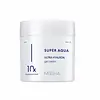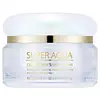What's inside
What's inside
 Key Ingredients
Key Ingredients

 Benefits
Benefits

 Concerns
Concerns

 Ingredients Side-by-side
Ingredients Side-by-side

Water
Skin ConditioningGlycerin
HumectantDiglycerin
HumectantNiacinamide
SmoothingTrehalose
Humectant1,2-Hexanediol
Skin ConditioningCaprylic/Capric Triglyceride
MaskingVinyldimethicone
Pentylene Glycol
Skin ConditioningCaprylyl Methicone
Skin ConditioningIsoamyl Laurate
EmollientAcrylates/C10-30 Alkyl Acrylate Crosspolymer
Emulsion StabilisingAmmonium Acryloyldimethyltaurate/Vp Copolymer
Hydroxyacetophenone
AntioxidantTromethamine
BufferingGlyceryl Acrylate/Acrylic Acid Copolymer
HumectantDimethiconol
EmollientCitrus Aurantium Bergamia Fruit Oil
MaskingXanthan Gum
EmulsifyingAdenosine
Skin ConditioningCitric Acid
BufferingCetearyl Olivate
Lavandula Angustifolia Oil
MaskingSorbitan Olivate
EmulsifyingCitrus Aurantium Dulcis Peel Oil
MaskingSodium Phytate
Dipotassium Glycyrrhizate
HumectantPinus Sylvestris Leaf Oil
MaskingPropanediol
SolventSodium Hyaluronate
HumectantBenzyl Glycol
SolventHydrolyzed Glycosaminoglycans
HumectantHydroxypropyltrimonium Hyaluronate
Sodium Hyaluronate Crosspolymer
HumectantGlyceryl Glucoside
HumectantHydrolyzed Hyaluronic Acid
HumectantButylene Glycol
HumectantEthylhexylglycerin
Skin ConditioningXylitylglucoside
HumectantMethyl Diisopropyl Propionamide
MaskingAnhydroxylitol
HumectantSodium Acetylated Hyaluronate
HumectantDipropylene Glycol
HumectantXylitol
HumectantSucrose Palmitate
EmollientHydrogenated Lecithin
EmulsifyingHyaluronic Acid
HumectantHydrolyzed Sodium Hyaluronate
Skin ConditioningMacadamia Ternifolia Seed Oil
EmollientOlea Europaea Fruit Oil
MaskingSimmondsia Chinensis Seed Oil
EmollientVitis Vinifera Seed Oil
EmollientActinidia Polygama Fruit Extract
Skin ConditioningCholeth-24
EmulsifyingGlyceryl Caprylate
EmollientPotassium Hyaluronate
Skin ConditioningMagnesium Chloride
Tetradecyl Aminobutyroylvalylaminobutyric Urea Trifluoroacetate
Skin ConditioningCeramide NP
Skin ConditioningWater, Glycerin, Diglycerin, Niacinamide, Trehalose, 1,2-Hexanediol, Caprylic/Capric Triglyceride, Vinyldimethicone, Pentylene Glycol, Caprylyl Methicone, Isoamyl Laurate, Acrylates/C10-30 Alkyl Acrylate Crosspolymer, Ammonium Acryloyldimethyltaurate/Vp Copolymer, Hydroxyacetophenone, Tromethamine, Glyceryl Acrylate/Acrylic Acid Copolymer, Dimethiconol, Citrus Aurantium Bergamia Fruit Oil, Xanthan Gum, Adenosine, Citric Acid, Cetearyl Olivate, Lavandula Angustifolia Oil, Sorbitan Olivate, Citrus Aurantium Dulcis Peel Oil, Sodium Phytate, Dipotassium Glycyrrhizate, Pinus Sylvestris Leaf Oil, Propanediol, Sodium Hyaluronate, Benzyl Glycol, Hydrolyzed Glycosaminoglycans, Hydroxypropyltrimonium Hyaluronate, Sodium Hyaluronate Crosspolymer, Glyceryl Glucoside, Hydrolyzed Hyaluronic Acid, Butylene Glycol, Ethylhexylglycerin, Xylitylglucoside, Methyl Diisopropyl Propionamide, Anhydroxylitol, Sodium Acetylated Hyaluronate, Dipropylene Glycol, Xylitol, Sucrose Palmitate, Hydrogenated Lecithin, Hyaluronic Acid, Hydrolyzed Sodium Hyaluronate, Macadamia Ternifolia Seed Oil, Olea Europaea Fruit Oil, Simmondsia Chinensis Seed Oil, Vitis Vinifera Seed Oil, Actinidia Polygama Fruit Extract, Choleth-24, Glyceryl Caprylate, Potassium Hyaluronate, Magnesium Chloride, Tetradecyl Aminobutyroylvalylaminobutyric Urea Trifluoroacetate, Ceramide NP
Snail Secretion Filtrate
Skin ConditioningDimethicone
EmollientGlycerin
HumectantAlcohol
AntimicrobialAdansonia Digitata Seed Extract
Skin ConditioningArbutin
AntioxidantBis-PEG-18 Methyl Ether Dimethyl Silane
EmollientPEG-11 Methyl Ether Dimethicone
EmulsifyingSea Water
HumectantEthylhexyl Isononanoate
EmollientHydroxyethyl Acrylate/Sodium Acryloyldimethyl Taurate Copolymer
Emulsion StabilisingPortulaca Oleracea Extract
Skin ConditioningCarbomer
Emulsion StabilisingTriethanolamine
BufferingPEG-40 Hydrogenated Castor Oil
EmulsifyingPPG-26-Buteth-26
Skin ConditioningCaprylyl Glycol
EmollientParfum
MaskingEthylhexylglycerin
Skin ConditioningTocopheryl Acetate
AntioxidantAdenosine
Skin ConditioningDisodium EDTA
Centella Asiatica Meristem Cell Culture
AntioxidantXanthan Gum
EmulsifyingSnail Secretion Filtrate, Dimethicone, Glycerin, Alcohol, Adansonia Digitata Seed Extract, Arbutin, Bis-PEG-18 Methyl Ether Dimethyl Silane, PEG-11 Methyl Ether Dimethicone, Sea Water, Ethylhexyl Isononanoate, Hydroxyethyl Acrylate/Sodium Acryloyldimethyl Taurate Copolymer, Portulaca Oleracea Extract, Carbomer, Triethanolamine, PEG-40 Hydrogenated Castor Oil, PPG-26-Buteth-26, Caprylyl Glycol, Parfum, Ethylhexylglycerin, Tocopheryl Acetate, Adenosine, Disodium EDTA, Centella Asiatica Meristem Cell Culture, Xanthan Gum
Ingredients Explained
These ingredients are found in both products.
Ingredients higher up in an ingredient list are typically present in a larger amount.
Adenosine is in every living organism. It is one of four components in nucleic acids that helps store our DNA.
Adenosine has many benefits when used. These benefits include hydrating the skin, smoothing skin, and reducing wrinkles. Once applied, adenosine increases collagen production. It also helps with improving firmness and tissue repair.
Studies have found adenosine may also help with wound healing.
In skincare products, Adenosine is usually derived from yeast.
Learn more about AdenosineEthylhexylglycerin (we can't pronounce this either) is commonly used as a preservative and skin softener. It is derived from glyceryl.
You might see Ethylhexylglycerin often paired with other preservatives such as phenoxyethanol. Ethylhexylglycerin has been found to increase the effectiveness of these other preservatives.
Glycerin is already naturally found in your skin. It helps moisturize and protect your skin.
A study from 2016 found glycerin to be more effective as a humectant than AHAs and hyaluronic acid.
As a humectant, it helps the skin stay hydrated by pulling moisture to your skin. The low molecular weight of glycerin allows it to pull moisture into the deeper layers of your skin.
Hydrated skin improves your skin barrier; Your skin barrier helps protect against irritants and bacteria.
Glycerin has also been found to have antimicrobial and antiviral properties. Due to these properties, glycerin is often used in wound and burn treatments.
In cosmetics, glycerin is usually derived from plants such as soybean or palm. However, it can also be sourced from animals, such as tallow or animal fat.
This ingredient is organic, colorless, odorless, and non-toxic.
Glycerin is the name for this ingredient in American English. British English uses Glycerol/Glycerine.
Learn more about GlycerinXanthan gum is used as a stabilizer and thickener within cosmetic products. It helps give products a sticky, thick feeling - preventing them from being too runny.
On the technical side of things, xanthan gum is a polysaccharide - a combination consisting of multiple sugar molecules bonded together.
Xanthan gum is a pretty common and great ingredient. It is a natural, non-toxic, non-irritating ingredient that is also commonly used in food products.
Learn more about Xanthan Gum